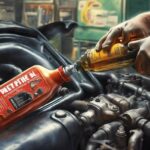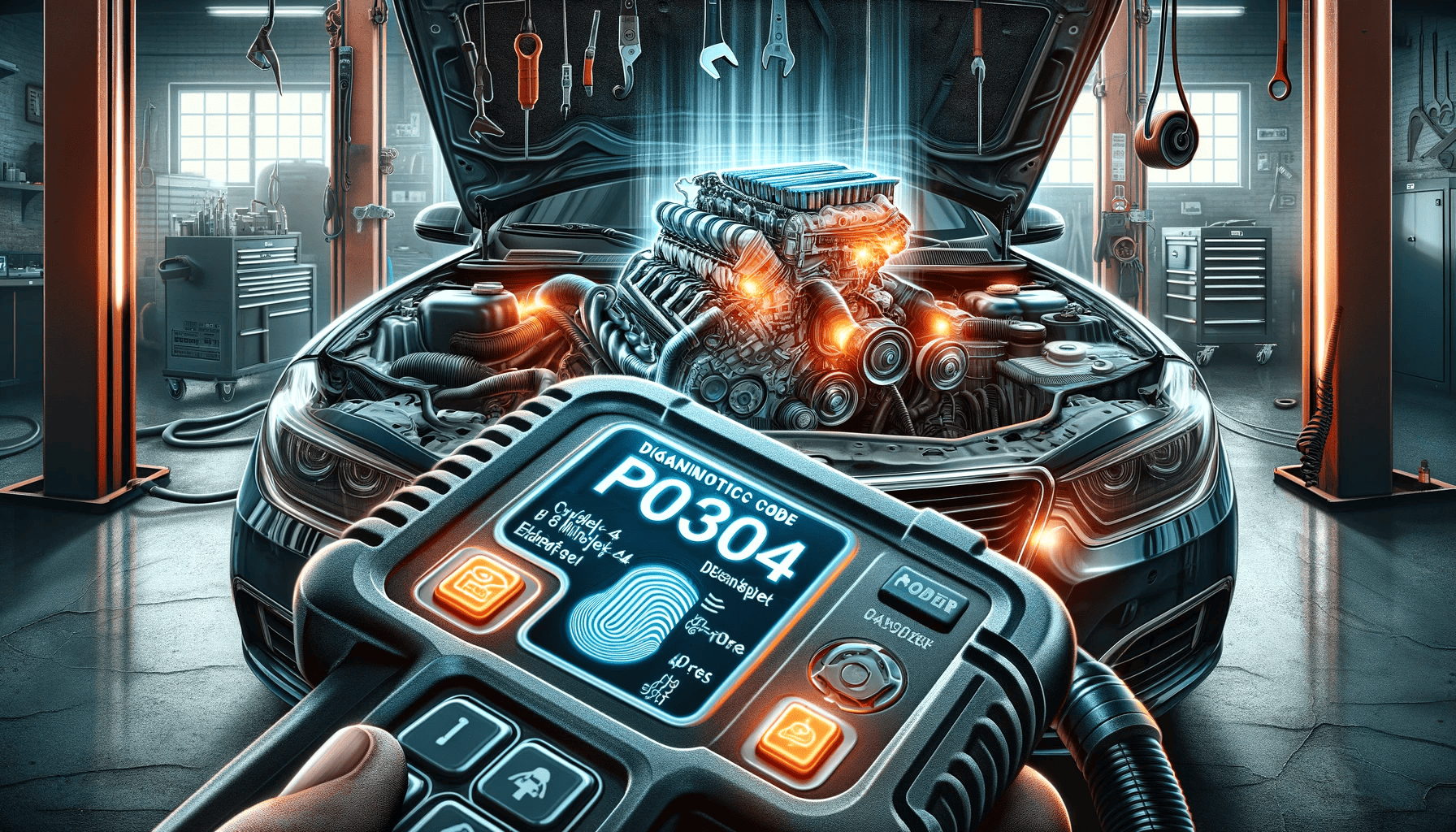The P0304 code is a clear signal from the vehicle’s onboard diagnostics system, indicating that Cylinder 4 is experiencing a misfire. This error code is part of the broader range of OBD2 codes utilized for engine diagnostics across various makes and models of vehicles.
Recognizing P0304 is critical for a driver because it points to a misfire that, if left unaddressed, can lead to more severe engine problems, decreased performance, and increased emissions.
A cylinder misfires when it fails to efficiently burn the air-fuel mixture, interrupting the engine’s normal operation and potentially leading to higher emissions, reduced fuel economy, and diminished power.
The causes of a P0304 code can be numerous, ranging from simple factors like worn out spark plugs or ignition coils to more complex issues such as fuel delivery problems or compression losses.
Diagnosis of a P0304 code typically involves a mechanic conducting a series of tests to pinpoint the exact cause of the misfire. Since the code specifically identifies Cylinder 4, the diagnosis will focus on the components associated with that cylinder.
These components might include the spark plug, ignition coil, fuel injector, and the mechanical integrity of the cylinder itself.
Understanding Engine Code P0304
When it comes to the code P0304, it specifies a particular fault within the vehicle’s engine operations.
- P stands for Powertrain, indicating the issue relates to the engine, transmission, and associated systems.
- 0 signifies that the code is a standardized OBD-II code relevant across different vehicle makes and models.
- 3 alerts you that the problem is related to the ignition system or a misfire.
- 04 reveals that the misfire has been detected specifically in cylinder 4.
A P0304 code means that Cylinder 4 is experiencing misfiring, which can disrupt the combustion process and engine performance.
“Cylinder 4 Misfire Detected” tells mechanics that they should look towards ignition problems, such as the spark plugs, or fuel-related issues within cylinder 4 of the engine.
Diagnosing And Troubleshooting
Common Symptoms Of The OBD Code P0304
The most immediate indicators of a P0304 code include:
- Misfiring: The engine may run unevenly or misfire, typically felt as jerking or a sudden loss of power.
- Shaking: A pronounced shake or vibration of the vehicle, especially at idle.
- Rough Idle: The engine may exhibit a rough or choppy idle.
- Hesitation: Noticeable hesitation when accelerating.
- Stalling: The vehicle may stall during operation.
- Hard Start: Difficulty starting the engine can be a symptom of a misfire condition.
Performing A Compression Test
- Secure a compression tester and remove the spark plug from cylinder 4.
- Install the tester into the spark plug hole.
- Have someone crank the engine while you observe the gauge.
A low reading could indicate problems with the cylinder’s ability to compress air and fuel—resulting from valve issues, piston damage, or a blown head gasket.
Other Diagnostic Methods
- Ignition System Inspections: Check the spark plugs, spark plug wires, and coil packs for damage or wear. A damaged ignition coil can lead directly to misfiring.
- Fuel System Checks: Use a fuel pressure gauge to ensure the fuel system maintains the correct pressure.
- Sensor Diagnostics: Utilize a digital multimeter to test the sensors that could impact the engine’s air-fuel mixture.
- Scan Tool Analysis: Connect a scan tool to read freeze frame data and additional trouble codes that may indicate related issues.
What Are the Potential Causes of Cylinder Misfire Issues?
Potential causes of common cylinder deactivation problems can include faulty spark plugs, clogged fuel injectors, vacuum leaks, or issues with the ignition coil. Additionally, low compression in the engine cylinders, a malfunctioning EGR valve, or a failing mass air flow sensor could also contribute to cylinder misfires.
What Are the Common Causes of Cylinder Misfires in Different Engine Cylinders?
When trying to troubleshoot p0306 cylinder misfire, it’s important to consider common causes such as faulty spark plugs, fuel injector issues, compression problems, or vacuum leaks. Identifying the specific cause can help in addressing the misfire and preventing further engine damage.
Are Cylinder Misfire Issues Related to the P0420 Engine Code in Ford F-150?
Yes, cylinder misfire issues can be related to the engine code P0420 in Ford F-150. The P0420 code indicates a problem with the catalytic converter, which can lead to misfires. Getting a proper engine code P0420 diagnosis fix is crucial for resolving these issues and ensuring the optimal performance of the vehicle.
Effective Solutions And Fixes
When faced with a P0304 error code, it is important to address it promptly to avoid further engine damage. This section outlines specific steps to rectify the misfire and restore engine performance.
How To Fix This OBD Code
Treating a P0304 code is often a step-by-step diagnostic and repair process, starting with the most simple and common issues before proceeding to more complex ones. The following are initial checks and repairs that can be conducted:
- Spark Plug Inspection: Examine the spark plugs of cylinder 4 for any signs of wear or damage. If the spark plug is found to be faulty, replacing the spark plug can often solve the misfire.
- Ignition Coil Assessment: If the ignition coils are malfunctioning, they could lead to a misfire. Testing and, if needed, replacing the ignition coil specific to cylinder 4 might resolve the issue.
- Fuel Injector Function: Ensure that the fuel injector for the affected cylinder is functioning properly. A clogged or defective injector can cause a misfire which necessitates cleaning or replacement.
- Vacuum Leak Detection: Check for a vacuum leak that could be impacting the air-fuel mixture. Identifying and repairing any vacuum leaks is crucial for maintaining engine performance.
- Fuel System Evaluation: Inspect the fuel pump and other related components to make sure that the fuel system is delivering sufficient fuel to the engine.
- Engine Compression Test: Perform a compression test to check for mechanical issues that could be causing the misfire.
Addressing Cylinder 4 Misfire
To specifically target a cylinder 4 misfire, additional considerations are required:
- Faulty Coil Pack: A failed coil pack could be responsible for a cylinder-specific misfire. Inspect the coil pack for signs of failure and replace it if necessary.
- Spark Plug Replacement: If a worn or damaged spark plug is isolated to cylinder 4, changing the spark plug for that particular cylinder may rectify the misfire.
- Catalytic Converter: In more severe cases, a misfire can lead to damage to the catalytic converter. This requires a professional diagnosis and potential replacement.
Frequently Asked Questions
Navigating the issues surrounding a P0304 trouble code is straightforward when one is equipped with the right information. The FAQs below provide clarity on symptoms, resolution strategies, and costs related to a cylinder 4 misfire.
What are the common symptoms indicating a cylinder 4 misfire?
Symptoms of a misfire in cylinder 4, associated with the P0304 code, often include rough idling, reduced fuel efficiency, and a noticeable lack of power. The Check Engine light will also illuminate as a primary warning signal.
How can a P0304 code be resolved in a Ford vehicle?
For a Ford vehicle displaying a P0304 code, common fixes can involve replacing the ignition coil, spark plug, or fuel injector. These components should be inspected and serviced by a professional mechanic to ensure proper resolution.
What steps should be taken if a cylinder 4 misfire occurs after changing spark plugs?
If a cylinder 4 misfire occurs after changing spark plugs, it is advisable to recheck the installation for any errors. Ensure that the spark plugs are of the correct type and properly gapped, and that all connectors are secure.
How can you determine the location of cylinder 4 in an engine?
Determining the location of cylinder 4 requires consulting the vehicle’s service manual, as the cylinder numbering and layout can vary between engine designs. Cylinder 4 is usually labeled on the engine block or identified in the vehicle’s documentation.
What are the potential repair costs associated with fixing a cylinder 4 misfire?
Repair costs for a cylinder 4 misfire can vary widely. They may range from relatively minor, such as the cost of a new spark plug, to more significant expenses if the issue is due to a failing component such as a fuel injector or catalytic converter.
What should be the course of action when encountering a permanent P0304 trouble code?
When encountering a permanent P0304 trouble code, immediate diagnosis and repair is crucial to prevent further engine damage. A mechanic should inspect the ignition system, fuel system, and perform a compression test to pinpoint the exact cause of the misfire.
As an Amazon Associate we earn from qualifying purchases.









When I start my car, it shakes a lot and sometimes it feels like it’s going to stall, especially when I’m idling. Could this be because of a cylinder misfire?
I’ve been trying to get to grips with this P0304 code that my car has been showing, and I found the compression test section particularly daunting. Could you explain how exactly a low compression reading directly ties into misfire issues, and what could be the underlying causes of such a compression problem in cylinder 4?